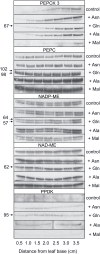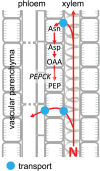Nitrogen recycling from the xylem in rice leaves: dependence upon metabolism and associated changes in xylem hydraulics
- PMID: 27053722
- PMCID: PMC4861031
- DOI: 10.1093/jxb/erw132
Nitrogen recycling from the xylem in rice leaves: dependence upon metabolism and associated changes in xylem hydraulics
Abstract
Measurements of amino acids in the guttation fluid and in the xylem exudates of cut leaves from intact plants provide evidence of the remarkable efficiency with which these nitrogenous compounds are reabsorbed from the xylem sap. This could be achieved by mechanisms involving intercellular transport and/or metabolism. Developmental changes in transcripts and protein showed that transcripts for phosphoenolpyruvate carboxykinase (PEPCK) increased from the base to the leaf tip, and were markedly increased by supplying asparagine. Supplying amino acids also increased the amounts of protein of PEPCK and, to a lesser extent, of pyruvate, Pi dikinase. PEPCK is present in the hydathodes, stomata and vascular parenchyma of rice leaves. Evidence for the role of PEPCK was obtained by using 3-mercaptopicolinic acid (MPA), a specific inhibitor of PEPCK, and by using an activation-tagged rice line that had an increase in PEPCK activity, to show that activation of PEPCK resulted in a decrease in N in the guttation fluid and that treatment by MPA resulted in an increase in amino acids in the guttation fluid and xylem sap towards the leaf tip. Furthermore, increasing PEPCK activity decreased the amount of guttation fluid, whereas decreasing PEPCK activity increased the amount of xylem sap or guttation fluid towards the leaf tip. The findings suggest the following hypotheses: (i) both metabolism and transport are involved in xylem recycling and (ii) excess N is the signal involved in modulating xylem hydraulics, perhaps via nutrient regulation of water-transporting aquaporins. Water relations and vascular metabolism and transport are thus intimately linked.
Keywords: Amides; amino acids; asparagine; hydathode; phosphoenolpyruvate carboxykinase; rice (Oryza sativa); xylem..
© The Author 2016. Published by Oxford University Press on behalf of the Society for Experimental Biology.
Figures






Similar articles
-
Phosphoenolpyruvate carboxykinase in developing pea seeds is associated with tissues involved in solute transport and is nitrogen-responsive.Plant Cell Environ. 2007 Feb;30(2):225-35. doi: 10.1111/j.1365-3040.2006.01622.x. Plant Cell Environ. 2007. PMID: 17238913
-
Are isocitrate lyase and phosphoenolpyruvate carboxykinase involved in gluconeogenesis during senescence of barley leaves and cucumber cotyledons?Plant Cell Physiol. 2000 Aug;41(8):960-7. doi: 10.1093/pcp/pcd021. Plant Cell Physiol. 2000. PMID: 11038056
-
Ion gradients in xylem exudate and guttation fluid related to tissue ion levels along primary leaves of barley.Plant Cell Environ. 2013 Oct;36(10):1826-37. doi: 10.1111/pce.12090. Epub 2013 Apr 8. Plant Cell Environ. 2013. PMID: 23464633
-
Mangroves in the Leaves: Anatomy, Physiology, and Immunity of Epithemal Hydathodes.Annu Rev Phytopathol. 2019 Aug 25;57:91-116. doi: 10.1146/annurev-phyto-082718-100228. Epub 2019 May 17. Annu Rev Phytopathol. 2019. PMID: 31100996 Review.
-
Does phosphoenolpyruvate carboxykinase have a role in both amino acid and carbohydrate metabolism?Amino Acids. 2001;20(3):225-41. doi: 10.1007/s007260170041. Amino Acids. 2001. PMID: 11354601 Review.
Cited by
-
Targeting Nitrogen Metabolism and Transport Processes to Improve Plant Nitrogen Use Efficiency.Front Plant Sci. 2021 Mar 1;11:628366. doi: 10.3389/fpls.2020.628366. eCollection 2020. Front Plant Sci. 2021. PMID: 33732269 Free PMC article. Review.
-
Gluconeogenesis in Plants: A Key Interface between Organic Acid/Amino Acid/Lipid and Sugar Metabolism.Molecules. 2021 Aug 24;26(17):5129. doi: 10.3390/molecules26175129. Molecules. 2021. PMID: 34500562 Free PMC article. Review.
-
Intramolecular carbon isotope signals reflect metabolite allocation in plants.J Exp Bot. 2022 Apr 18;73(8):2558-2575. doi: 10.1093/jxb/erac028. J Exp Bot. 2022. PMID: 35084456 Free PMC article.
-
Bioinformatic Exploration of the Targets of Xylem Sap miRNAs in Maize under Cadmium Stress.Int J Mol Sci. 2019 Mar 23;20(6):1474. doi: 10.3390/ijms20061474. Int J Mol Sci. 2019. PMID: 30909604 Free PMC article.
-
Phosphoenolpyruvate Carboxykinase (PCK) in the Brain Gluconeogenic Pathway Contributes to Oxidative and Lactic Injury After Stroke.Mol Neurobiol. 2021 May;58(5):2309-2321. doi: 10.1007/s12035-020-02251-3. Epub 2021 Jan 8. Mol Neurobiol. 2021. PMID: 33417227
References
-
- Atkins CA., Smith PMC, Rodriguez-Medina C. 2011. Macromolecules in phloem exudates-a review. Protoplasma 248, 165–172. - PubMed
-
- Brown JWS, Echeverria M, Qu L-H. 2003. Plant snoRNAs: functional evolution and new modes of gene expression. Trends in Plant Science 8, 42–49. - PubMed
-
- Brown NJ, Palmer BG, Stanley S, et al. 2010. C4 acid decarboxylases required for C4 photosynthesis are active in the mid-vein of the C3 species Arabidopsis thaliana, and are important in sugar and amino acid metabolism. Plant Journal 61, 122–133. - PubMed
Publication types
MeSH terms
Substances
LinkOut - more resources
Full Text Sources
Other Literature Sources
Molecular Biology Databases
Research Materials
Miscellaneous

